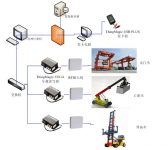
UHF RFID container management system based on RFID technology
[ad_1]
1. Background
Containers are the main transportation equipment of international logistics. 90% of international freight is completed by container transportation. In 2006, the global container throughput reached 421 million TEU and the container trade volume reached 117 million TEU. Containers have obvious advantages in transportation, mainly in terms of ensuring cargo safety, saving packaging costs, improving loading and unloading efficiency, and accelerating capital flow.
However, there are still many problems in the current container transportation management. This is mainly due to the traditional management mode. The staff manually record the location of each container, and then manually enter the data into the container management system. In the database, the binding of container data and actual storage data is completed. In the face of such a large-scale, international freight transportation circulation carrier, the information collection, tracking and supervision of container numbers are mostly done manually or manually. Due to the inaccurate identification of container numbers, errors in manual data transcription, delays in information transmission, etc., the entire container management is chaotic, and it can no longer meet the requirements of modern logistics management.
2. Technology Application
RFID is a “radio frequency identification” non-contact automatic identification technology, which can realize automatic identification of stationary or moving objects and people. RFID technology automatically recognizes target objects through radio frequency signals and obtains relevant data. The recognition work does not require human intervention, can work in various environments, can identify high-speed moving objects and simultaneously recognize multiple targets. RFID technology can be used to locate and identify almost all physical objects, and it is one of the important means of informatization in the field of identification.
After recent years of development, RFID technology has been widely used in production, logistics, transportation, transportation, medical treatment, anti-counterfeiting, tracking, equipment and asset management and other application fields that require data collection and processing. It is considered to be a future substitute for barcode labels. Taste.
Applying RFID technology to container management, using the advantages of RFID technology in the field of automatic identification, developing a container information management platform, and greatly improving the efficiency and benefits of container transportation management is very meaningful.
3. Scheme design
The information level of the current container logistics process is one of the bottlenecks restricting the development of today’s container transportation. Since the container itself does not contain information, during the transportation process, the flow and identification of the container can only be operated manually, which greatly affects the efficiency of transportation, loading and unloading, and management. For the global container supply chain, it is extremely important to accurately obtain the location and safety information of the goods, realize the transparency of the supply chain, optimize the management, reduce the uncertainty of the inventory and transportation cycle, and improve the efficiency and benefits of the supply chain. The urgent need of logistics.
The overall structure of the system is as follows:

By installing RFID electronic tags in the containers, and installing RFID readers on various business process operation equipment, during business operations, the RFID readers read the electronic tag data, obtain the container information, and then transmit it to the background for centralized processing through the network. The system realizes the tracking and management of the entire container, and realizes real-time scientific dispatch and capacity allocation of container transportation equipment.
3.1 System flow

3.2 Key technology
In the system, the core RFID data collection equipment will be installed in mechanical equipment such as gantry cranes, reach stackers and stackers. In the application of this type of equipment, RFID readers should have basic data collection functions as well The standards for the use of on-board equipment have high requirements for high and low temperature, electromagnetic compatibility, low frequency vibration, impact, etc., and the working environment is mostly outdoors, and the environmental conditions are also relatively harsh, which raises higher requirements for the selection of the entire RFID reader Challenge.
Quanshunhong ThingMagic-Vega is an automotive-grade RFID reader, which has passed the automotive industry standard: TS16949. The built-in high-performance ThingMagic UHF UHF RFID module meets the requirements of harsh environment operating standards and is very suitable for deployment in vehicle applications.
As the agent of ThingMagic, Shenzhen Quanshunhong Technology Co., Ltd. is actively developing the Internet of Things environment in China. It focuses on providing customers with RFID modules, RFID readers, RFID handheld terminals, etc. Power consumption, small size, industrial-grade professional, high-performance RFID equipment. With a professional technical team, high-quality service and preferential prices, Quanshunhong Technology provides our customers with world-class RFID equipment solutions and high-quality after-sales service.
[ad_2]



